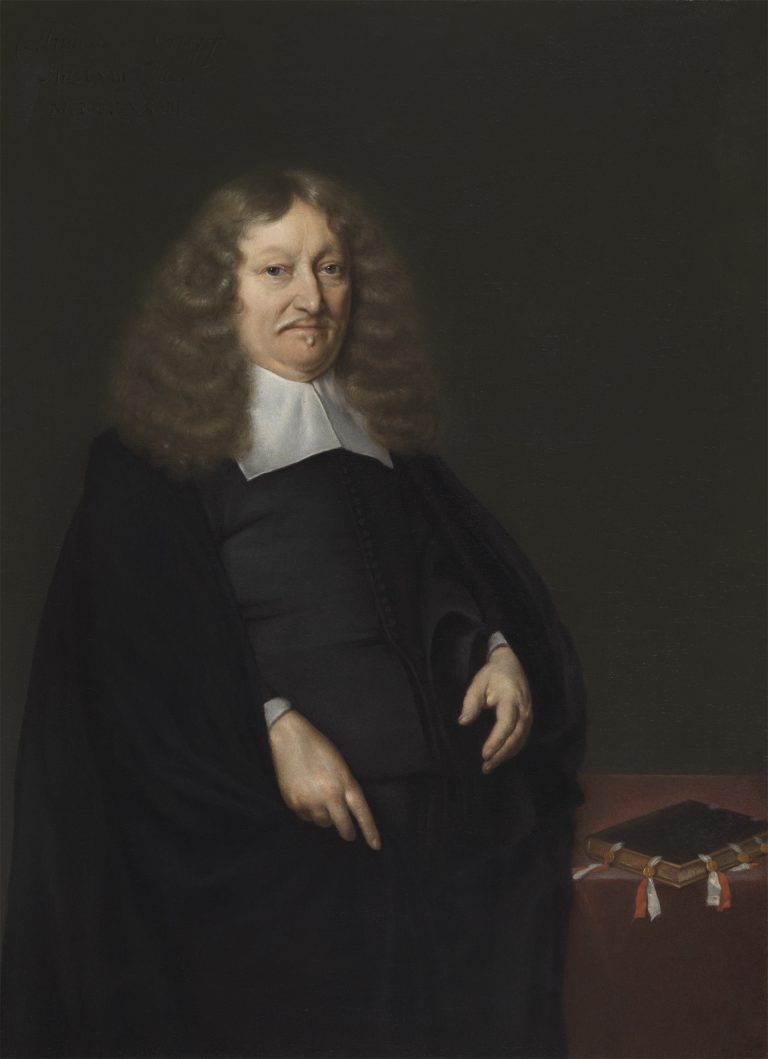Andries de Graeff (1611–78) was one of the wealthiest and most influential men in the seventeenth-century Dutch Republic.1 He was the son of Jacob Dircksz de Graeff (several times burgomaster of Amsterdam) and Aeltge Boelens; through marriage and political affiliation he was allied with the powerful Bicker family, as well as with the Republican anti-Orangist raadpensionaris (Grand Pensionary) Johan de Witt (1625–72). In 1646 Andries married his niece, Elisabeth Bicker van Swieten (1623–56), and had three children by her. Especially after the death of his brother Cornelis in 1664, Andries was a dominant force in Amsterdam politics: he served seven terms as burgomaster between 1657 and 1672, and was a member of the vroedschap (city council) between 1665 and 1672. The change in government brought about by the closing of the First Stadholderless Period and the appointment of Willem III as stadholder of the Netherlands in 1672 signaled the end of De Graeff’s political career.
Around 1670 De Graeff built an impressive house on Amsterdam’s fashionable Herengracht, which he filled with the fruits of his assiduous collecting and patronage of the arts, including ceiling paintings by Gerard de Lairesse (now in the Vredespaleis, The Hague).2 De Graeff was instrumental in commissioning decorations for Amsterdam’s new Town Hall, and in 1660 helped organize a strategic gift of artworks to King Charles II of England. Alongside his commitment to the visual arts, De Graeff was also Maecenas to the poets Joost van den Vondel, Jan Vos, Caspar Barlaeus, and Gerard Brandt.
De Graeff was portrayed on several occasions by some of the most sought-after artists of the era: in paintings by Rembrandt van Rijn (1606–69) from 1639 (fig 1) and Govaert Flinck (1615–60) from the early 1650s, in a drawing by Jan Lievens (1607–74) from about 1657 (fig 2), and in a marble bust by Artus Quellinus (1609–68) made in 1661 (fig 3). Painted in 1673, Gerard ter Borch the Younger’s portrait is the last of these, depicting the subject at the age of sixty-two or sixty-three. De Graeff is dressed plainly, in a black doublet and breeches and wearing a simple flat linen collar; with both hands, he pulls close around him the black cloak draped over his shoulders. On the table at right is a slim book, closed securely with ribbons and seals. Despite the sober attire, Ter Borch’s portrait of De Graeff hints discreetly at some personal vanity: the man’s luxuriantly full and glossy brown wig is ill matched to his mustache and carefully clipped mouche, which reveal the silvery hair of a man in his sixties.3
Ter Borch painted several portraits of the extended De Graeff family (as well as other prominent Amsterdam sitters) while in Deventer between 1672 and 1674: Andries’s son Cornelis and Cornelis’ wife, Agneta Deutz, and his nephews Pieter and Jacob de Graeff.4 The portraits of Andries and Cornelis de Graeff are both inscribed with a date of 1674, which, as Dudok van Heel has shown, is incorrect. An entry in Pieter de Graeff’s almanac for 22 July 1673 mentions the commission for Ter Borch’s portrait of his brother Jacob and implies that the portrait of Cornelis was already completed by that date.5 Presumably Andries’s portrait was painted at about the same time. Although the inscriptions were added at a later date, they appear to be quite old (possibly from the eighteenth century); in both instances the painting’s craquelure also runs through the paint of the inscriptions.6
Three versions of Ter Borch’s Portrait of Andries de Graeff are extant. The present version was unknown to scholars until it was exhibited at the monographic Ter Borch exhibition held in The Hague and Münster in 1974. The painting did not find universal acceptance at the time; Gerson, in his review of the exhibition, suggested it might be by Caspar Netscher, although there is no specific stylistic reason to think this is the case.7 A second version of the portrait, in the Musée des Beaux-Arts, Dijon (fig 4), is probably a studio work. Another, weaker version, which is slightly larger in its dimensions, is in the Suermondt-Ludwig-Museum in Aachen. Although the Leiden Collection’s painting has probably been trimmed at the sides and at the top,8 the excellent condition of the paint surface allows one to appreciate fully Ter Borch’s sensitive depiction of this imposing individual.
